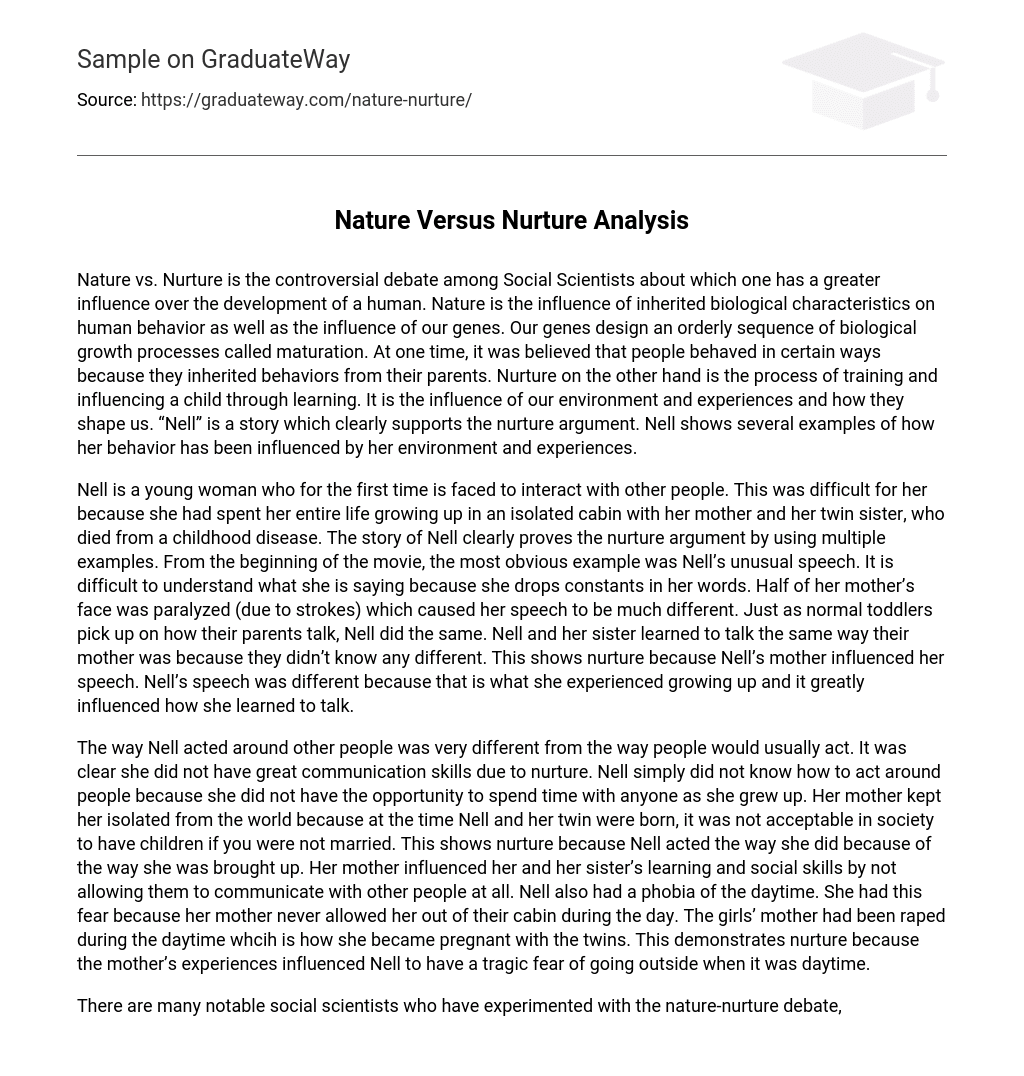Nature vs. Nurture is the controversial debate among Social Scientists about which one has a greater influence over the development of a human. Nature is the influence of inherited biological characteristics on human behavior as well as the influence of our genes. Our genes design an orderly sequence of biological growth processes called maturation. At one time, it was believed that people behaved in certain ways because they inherited behaviors from their parents. Nurture on the other hand is the process of training and influencing a child through learning. It is the influence of our environment and experiences and how they shape us. “Nell” is a story which clearly supports the nurture argument. Nell shows several examples of how her behavior has been influenced by her environment and experiences.
Nell is a young woman who for the first time is faced to interact with other people. This was difficult for her because she had spent her entire life growing up in an isolated cabin with her mother and her twin sister, who died from a childhood disease. The story of Nell clearly proves the nurture argument by using multiple examples. From the beginning of the movie, the most obvious example was Nell’s unusual speech. It is difficult to understand what she is saying because she drops constants in her words. Half of her mother’s face was paralyzed (due to strokes) which caused her speech to be much different. Just as normal toddlers pick up on how their parents talk, Nell did the same. Nell and her sister learned to talk the same way their mother was because they didn’t know any different. This shows nurture because Nell’s mother influenced her speech. Nell’s speech was different because that is what she experienced growing up and it greatly influenced how she learned to talk.
The way Nell acted around other people was very different from the way people would usually act. It was clear she did not have great communication skills due to nurture. Nell simply did not know how to act around people because she did not have the opportunity to spend time with anyone as she grew up. Her mother kept her isolated from the world because at the time Nell and her twin were born, it was not acceptable in society to have children if you were not married. This shows nurture because Nell acted the way she did because of the way she was brought up. Her mother influenced her and her sister’s learning and social skills by not allowing them to communicate with other people at all. Nell also had a phobia of the daytime. She had this fear because her mother never allowed her out of their cabin during the day. The girls’ mother had been raped during the daytime whcih is how she became pregnant with the twins. This demonstrates nurture because the mother’s experiences influenced Nell to have a tragic fear of going outside when it was daytime.
There are many notable social scientists who have experimented with the nature-nurture debate, and whose results have proven nurture. Margaret Mead is a scientist who is known for her experiment which looked at men/women’s gender roles. During her experiment, bother girls and boys were treated harshly and left to fend for themselves. They learned to view others as potential enemies. As a result, both men and women grew up to be hostile and aggressive. Margaret Mead concluded that most of the personality traits we associate with ‘masculinity’ and ‘femininity’ are the result of early learning, not heredity. Therefore, her experiment proved that nurture rather than nature determines human behavior.
Mead’s results were significant because people had accepted that men and women have roles defined by nature. Dr. Kellog is another scientist who is widely known for experimenting with the nature-nurture argument. Dr. Kellog brought a baby chimp into his house to see if his baby could teach it human characteristics. However, instead his baby began to pick up chimp-like characteristics, such as sounds and actions. This resulted in the chimp quickly being returned back to the lab. Dr.Kellog’s experiment proved how important nurture is to humans and how much our environment and experiences influence people’s learning.
After learning the story of “Nell” it is clear that the young woman represent the nurture side of the nature-nurture argument. Many examples help support this such as her unusually speech, behaviors, and fears, which are all influenced by her environment and experiences. There are many social scientists that have also proven that nurture is a very important aspect for humans, such as Margaret Mead and Dr. Kellog.





